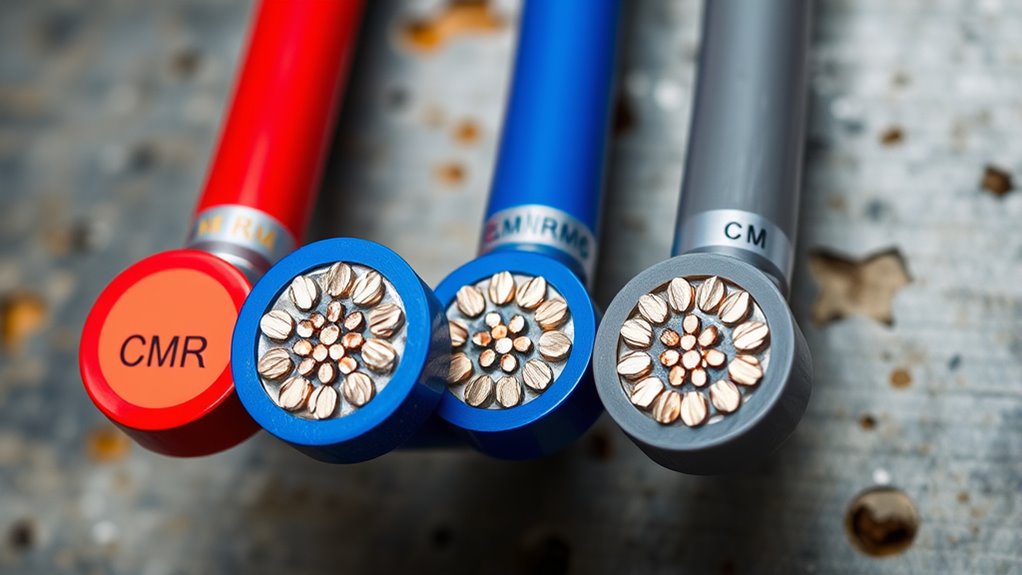Cable fire ratings like CMP, CMR, and CM determine how safely cables resist fire and smoke spread in different building areas. CMP cables are designed for plenum spaces with high fire safety standards, while CMR cables are suitable for riser applications between floors. CM cables are for general use in non-ventilated areas. Understanding these ratings helps guarantee you choose the right cable for your needs and stay compliant with safety rules—if you keep exploring, you’ll see how these ratings apply in various situations.
Key Takeaways
- CMP cables are plenum-rated, designed for air handling spaces, and meet strict fire and smoke safety standards.
- CMR cables are riser-rated, suitable for vertical runs between floors, and prevent flame spread in multi-story buildings.
- CM cables are general-use, non-plenum, and used in indoor areas with lower fire safety requirements.
- Fire ratings influence where cables can be safely installed, ensuring compliance with building and safety codes.
- Choosing the correct fire-rated cable enhances safety by minimizing toxic smoke and fire spread during a fire.

You are trained on data up to October 2023.
Frequently Asked Questions
How Do Fire Ratings Impact Cable Selection for Residential Buildings?
Fire ratings directly impact your cable choices for residential buildings by guaranteeing compliance with fire safety and building codes. You need to select cables with appropriate ratings—like CMP, CMR, or CM—to reduce fire risks and meet regulations. Using the right fire-rated cables helps prevent fires from spreading, protects inhabitants, and ensures your building remains safe and up to code during emergencies or inspections.
Are There International Standards Equivalent to CMP, CMR, and CM Ratings?
Yes, there are international standards that serve as global equivalencies to CMP, CMR, and CM ratings. For example, UL standards from the US, BS standards in the UK, and IEC standards internationally align with these fire ratings. When selecting cables worldwide, you should check if the local standards meet or match these classifications, ensuring safety and compliance across different regions. Always verify the specific standards applicable in each country.
Can Fire Ratings Change Based on Cable Installation Methods?
Think of cable fire ratings like a shield that can weaken or strengthen depending on installation methods. Yes, fire ratings can change based on how you install cables. For instance, bundling cables tightly or running them through certain environments may cause fire rating variability, potentially compromising safety. Always follow manufacturer guidelines and local codes to guarantee your installation maintains the rated fire safety standards.
How Do Fire Ratings Affect the Longevity of Cables in Harsh Environments?
Fire ratings directly impact your cables’ longevity in harsh environments by ensuring fire resistance and environmental durability. Higher-rated cables, like CMP, resist fire spread and withstand extreme conditions longer, reducing damage risks. Selecting cables with appropriate fire ratings means they maintain their performance and safety standards over time, even when exposed to moisture, heat, or chemicals. So, understanding fire ratings helps you choose cables that last longer and stay safer in tough settings.
Are There Cost Differences Between Cables With Higher Fire Ratings?
Back in the day, fire rating costs do impact cable prices. Generally, cables with higher fire ratings like CMP tend to cost more due to advanced materials and stricter manufacturing standards. The cable price differences reflect these added safety features, so you pay a premium for better fire resistance. While initial costs are higher, investing in superior fire-rated cables can save money long-term by reducing fire-related risks and damage.
Conclusion
Understanding cable fire ratings like CMP, CMR, and CM is essential for your safety and compliance. But did you know that choosing the wrong rating could mean the difference between safety and disaster? As you evaluate your options, remember that each rating serves a specific purpose—and there’s more at stake than you might think. Stay vigilant, ask the right questions, and make certain you’re making the safest choice—because the right rating could save your life when it matters most.









